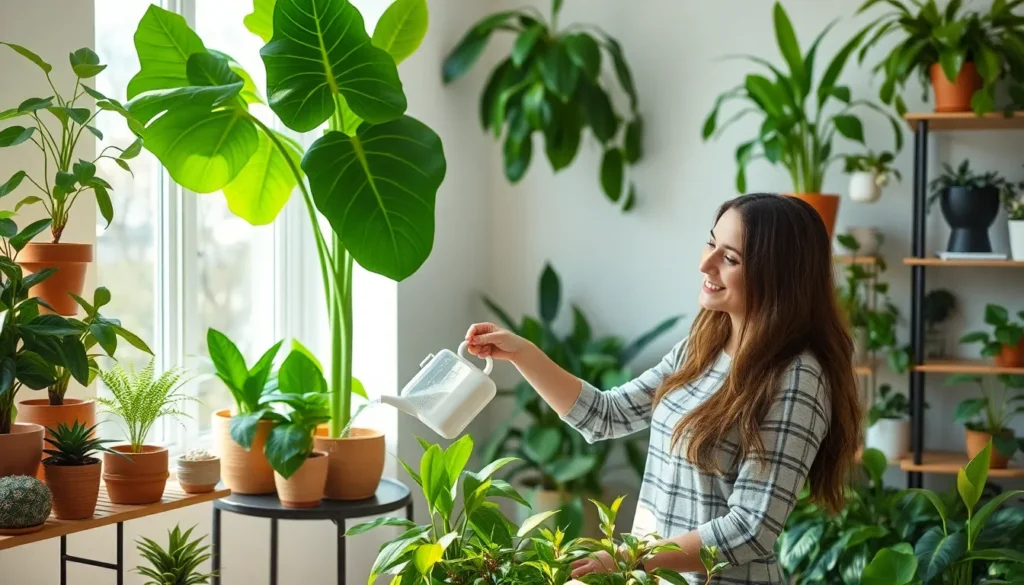Transform your living space into a green oasis that’ll make your neighbors jealous and your guests envious. Indoor plant displays aren’t just about throwing a few pots around your home – they’re about creating stunning visual arrangements that showcase nature’s beauty while maximizing your space.
We’ve all seen those Instagram-worthy plant displays that make us wonder how people achieve such effortless elegance. The secret isn’t having expensive plants or unlimited space – it’s knowing the right techniques for positioning, styling, and arranging your green companions to create maximum impact.
Whether you’re working with a tiny apartment or a spacious home, we’ll show you proven strategies that interior designers use to create captivating plant displays. From vertical gardens that draw the eye upward to strategic groupings that create natural focal points, you’ll discover how to turn any corner into a botanical masterpiece that brings life and personality to your indoor spaces.
Choose the Right Plants for Your Indoor Space
Selecting appropriate plants forms the foundation of any successful indoor display strategy. We need to match our plant choices with both environmental conditions and our gardening expertise to create thriving indoor arrangements.
Consider Light Requirements and Room Conditions
Assess your available natural light before purchasing any plants. Most indoor spaces fall into three categories: bright indirect light near windows, medium light in central room areas, and low light in corners or north-facing rooms.
Match plants to exact lighting conditions for optimal growth results. Snake plants and ZZ plants excel in low light areas while fiddle leaf figs and rubber trees require bright indirect light. Peace lilies and pothos adapt well to medium light conditions throughout your home.
Evaluate humidity levels in different rooms to select compatible species. Bathrooms with higher humidity suit ferns and air plants perfectly. Living rooms with standard humidity work well for most houseplants including monstera and spider plants.
Consider temperature fluctuations when choosing placement locations. Avoid placing tropical plants near heating vents or air conditioning units where temperature swings can stress the foliage. Consistent temperatures between 65-75°F support most indoor plant varieties effectively.
Select Plants Based on Your Experience Level
Start with low maintenance plants if you’re new to indoor gardening. Succulents like echeveria and jade plants require minimal watering and forgive occasional neglect. These hardy varieties help build confidence while you develop your plant care routine.
Choose forgiving species that recover quickly from care mistakes. Pothos vines bounce back from both overwatering and underwatering situations. Spider plants and rubber trees also tolerate inconsistent care schedules without showing important stress.
Graduate to more demanding plants as your skills develop over time. Fiddle leaf figs and calatheas require exact watering schedules and humidity levels. These beautiful specimens reward experienced plant parents with stunning foliage displays.
Consider your available time for plant maintenance when making selections. Fast-growing plants like monstera and philodendrons need regular pruning and repotting. Slower-growing options such as snake plants and ZZ plants require less frequent attention while still providing visual impact.
Find the Perfect Placement for Maximum Visual Impact
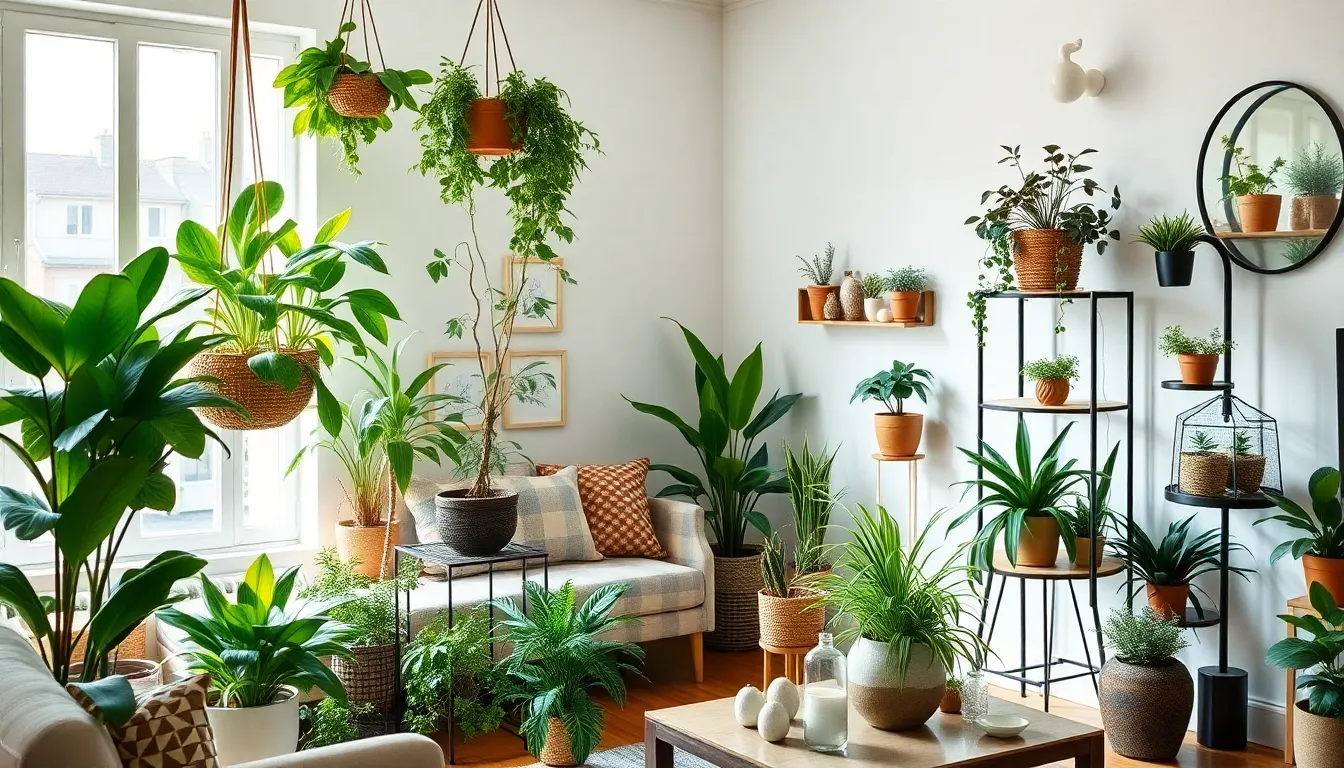
Strategic plant placement transforms ordinary rooms into vibrant living spaces that captivate attention and enhance your home’s aesthetic appeal.
Use Natural Light Sources Effectively
Maximize window opportunities by positioning plants near natural light sources where photosynthesis thrives. Hanging baskets work exceptionally well in front of windows, creating beautiful silhouettes while ensuring your plants receive adequate sunlight for healthy growth.
Match plants to available light conditions since some species need bright light while others flourish in shade. We recommend assessing each room’s natural light patterns throughout the day before selecting plant varieties to ensure longevity and vibrancy.
Avoid overcrowding plants in limited light areas to guarantee each specimen receives proper sunlight and air circulation. Spacing plants appropriately prevents competition for resources and maintains the health of your entire indoor garden.
Create Focal Points in Key Areas
Position plants in high visibility locations such as shelves, side tables, or empty corners that benefit from fresh green touches. These strategic placements ensure your botanical investments become conversation starters rather than overlooked decorations.
Use vertical space creatively by hanging plants from ceilings or placing them on wall-mounted shelves to draw the eye upward. This approach maximizes floor space while creating ever-changing visual layers that add depth to any room.
Group plants of varying heights and textures to form natural, eye-catching displays in living rooms, entryways, or near seating areas. Plant stands and tiered shelving help layer specimens at different elevations, adding dimension and visual interest to your arrangements.
Combine plants with decorative elements such as art pieces or unique containers to enhance the overall aesthetic appeal of your space. Consider incorporating terrariums, green living walls, or unique specimens like air plants on suspended branches or orchids climbing rustic ladders for personalized touches that reflect your style.
Select Appropriate Containers and Planters
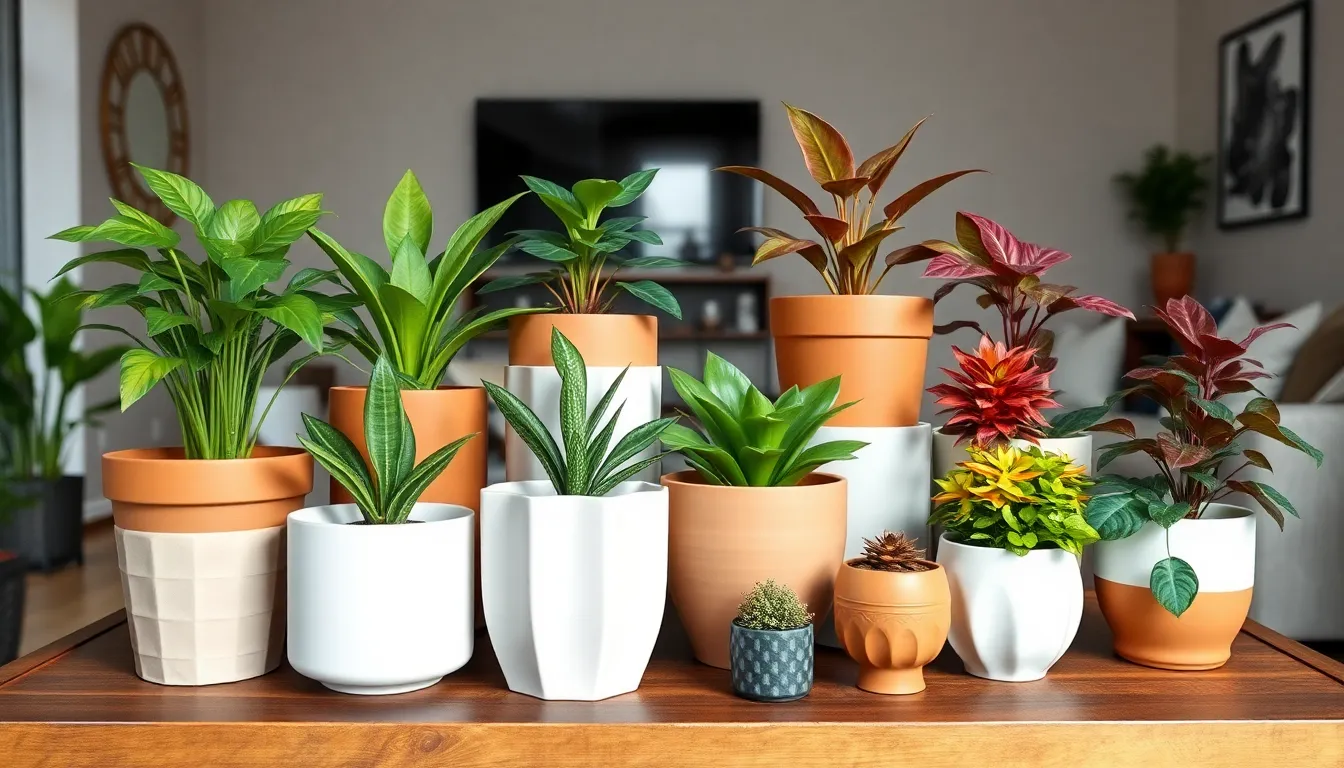
We need to choose containers that support both plant health and our home’s aesthetic appeal. The right planters transform ordinary houseplants into stunning decorative elements while providing optimal growing conditions.
Material Selection for Indoor Plant Containers
Choose porous materials like terracotta or ceramics that allow soil to dry evenly and prevent dangerous overwatering issues. These natural materials regulate moisture better than plastic alternatives and create healthier root environments for our plants.
Consider fiberglass planters for larger specimens over 8 inches in diameter since they’re lightweight yet durable options. We can easily move these containers when rearranging our displays or cleaning around plants.
Select pot sizes that match our plant types and growth stages appropriately. Small herbs or strawberries thrive in 10-inch pots, while larger herbs and compact shrubs need 14-16 inch containers for proper root development.
Opt for pots 18 inches or bigger when growing small trees or substantial vegetables indoors. These spacious containers accommodate extensive root systems and support healthy plant growth over time.
Pick new pots only 1-2 inches larger than the current root ball when transplanting to avoid excess moisture retention that leads to root rot.
Match Pot Styles to Your Home Decor
Coordinate pot colors and finishes with our existing interior design scheme to create cohesive visual flow throughout our spaces. Ceramic planters suit traditional homes, while bamboo containers complement natural or bohemian aesthetics perfectly.
Explore modern metallic designs for contemporary spaces that need sleek, sophisticated plant displays. Cement and stone planters add industrial charm to minimalist or urban-inspired interiors.
Use containers as decorative focal points that enhance our rooms while supporting plant health needs simultaneously. We can select statement pieces that draw attention or subtle options that blend seamlessly with surrounding furnishings.
Ensure Proper Drainage and Plant Health
Choose pots with drainage holes paired with matching saucers underneath to catch excess water and prevent root diseases from waterlogged soil conditions. Proper drainage remains the most critical factor for successful indoor plant care.
Install plastic nursery liners inside decorative pots without drainage holes to protect plant roots and maintain appropriate soil moisture levels. This method allows us to use beautiful containers while preserving plant health.
Monitor watering practices consistently based on our pot materials and exact plant requirements to maintain optimal growing conditions. Different materials affect soil moisture retention rates and influence how often we need to water our plants.
Create Stunning Plant Groupings and Arrangements
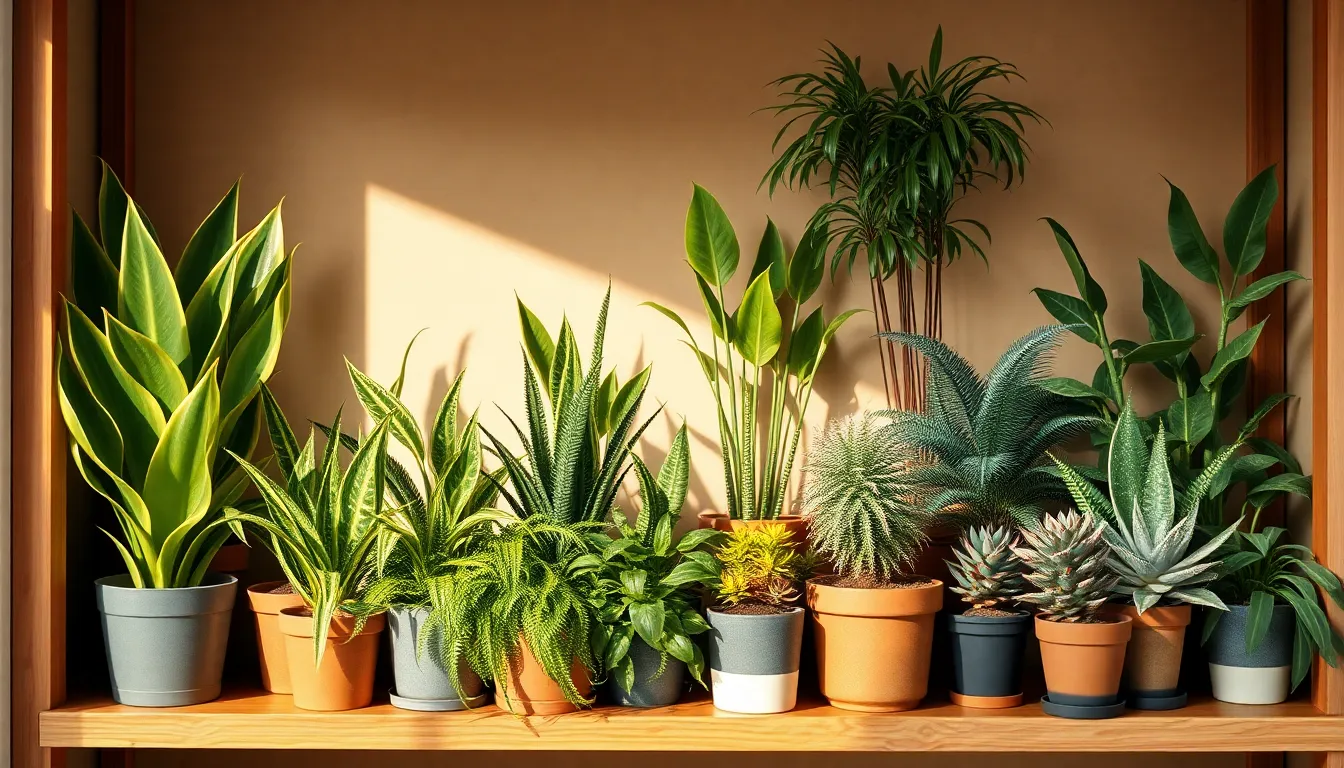
Grouping plants together creates more visual impact than scattering individual specimens throughout your space. We’ll show you how to arrange plants in cohesive displays that transform ordinary rooms into botanical showpieces.
Apply the Rule of Odds for Visual Appeal
Using odd numbers creates natural balance in your plant arrangements. We recommend grouping three, five, or seven plants together rather than even numbers to achieve this pleasing asymmetry.
Clustering plants in odd groupings adds rhythm and movement to your displays. These arrangements avoid the static feeling that comes from symmetrical or evenly spaced plant placement. Your eye naturally finds odd numbered groups more captivating and organic looking.
Combining plants from the same family works particularly well for these groupings. We suggest pairing cacti and succulents together or creating tropical plant clusters with similar care requirements. This approach helps establish beneficial microclimates while ensuring visual harmony throughout your arrangement.
Mix Different Heights and Textures
Playing with varying plant heights creates dimensional displays that draw attention. We combine large, medium, and small plants to form triangular compositions that give depth to any room. This layered approach prevents flat, monotonous arrangements.
Contrasting textures adds richness that keeps arrangements visually captivating. We pair glossy leaves with fuzzy foliage or combine spiky succulents with soft, trailing varieties. For example, bushy ferns create beautiful contrast when placed alongside sleek snake plants.
Incorporating different container materials enhances the textural diversity even further. We mix ceramic pots with woven baskets or wooden plant stands to complement our plant selections. These varied materials help integrate your botanical displays seamlessly into your existing interior decor.
Using plant stands, shelves, and hangers maximizes your vertical space while creating multi level arrangements. We position trailing plants at higher levels and upright specimens below to achieve ever-changing visual effects. This strategy works especially well in corners or along walls where you want to create stunning focal points.
Incorporate Vertical Display Solutions
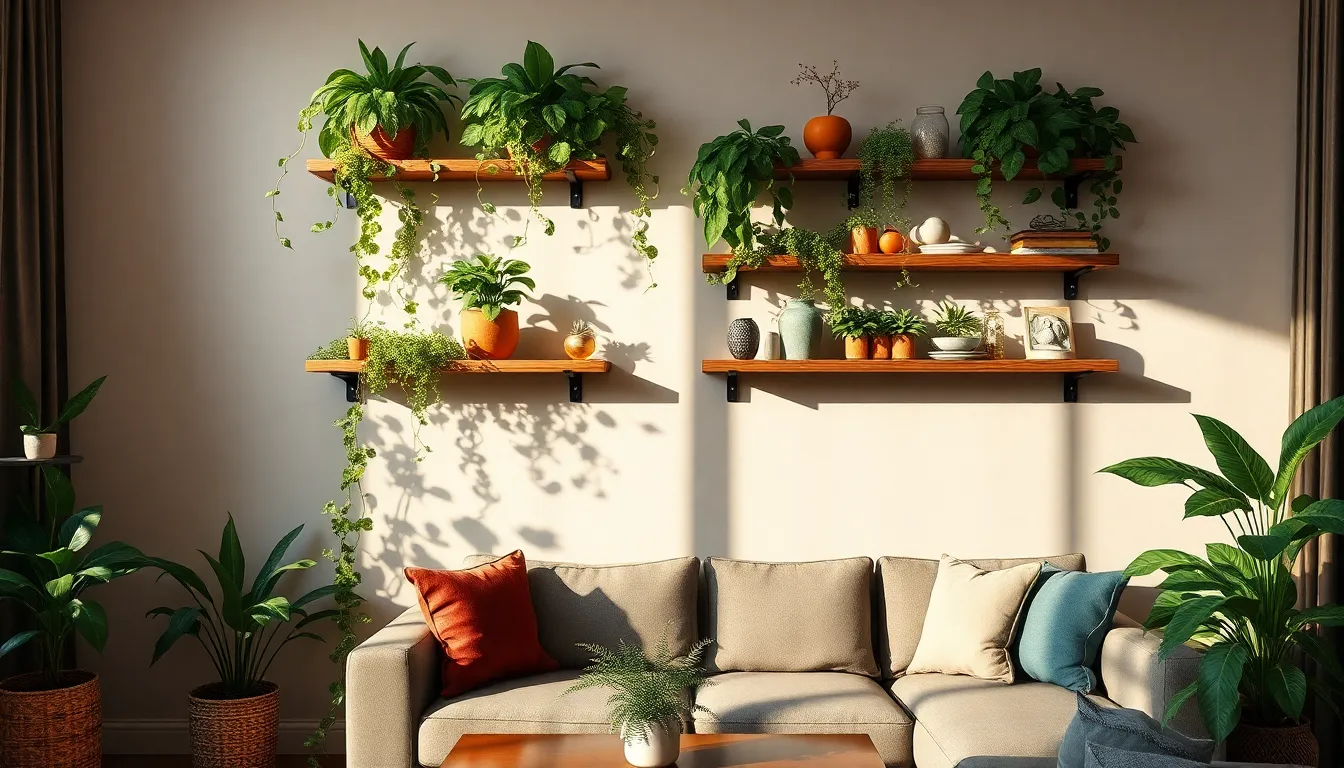
Vertical displays transform unused wall space into stunning green focal points that maximize our plant collection without consuming valuable floor area. We’ll create depth and visual interest by utilizing tiered arrangements that showcase multiple plants at varying heights.
Install Wall-Mounted Planters and Shelves
Wall-mounted planters offer flexible answers for displaying our indoor plants while softening room partitions and decorating blank walls. We can install floating shelves at different heights to create cascading arrangements that turn vertical surfaces into lush green features. Trailing plants like pothos and ivy work exceptionally well in wall planters, creating beautiful hanging greenery that enhances visual appeal.
Shelving systems allow us to showcase a variety of plants while maintaining easy watering access. We should choose containers that complement our existing decor and ensure proper drainage for plant health. Installing multiple shelves at staggered heights creates a ever-changing display that draws the eye upward and makes rooms feel larger.
Use Plant Stands and Hanging Options
Plant stands provide versatile layering opportunities that contribute to captivating plant compositions throughout our living spaces. We can arrange stands at different heights to create multi-level displays that showcase our plants’ unique characteristics. Combining various stand materials like wood, metal, or wicker adds textural interest to our arrangements.
Hanging planters suspended from ceilings or positioned in front of windows free up surface space while creating movement in our design. Macramé rope hangers, metal bowls, and terracotta pots offer popular options that suit various interior styles. We can hang trailing plants at eye level or higher to create dramatic cascading effects.
Window placement enhances our hanging displays by providing indirect sunlight essential for many indoor varieties. We should position hanging plants where they’ll receive adequate light while adding visual depth to our rooms through strategic placement at varying heights.
Style Plants with Decorative Accessories
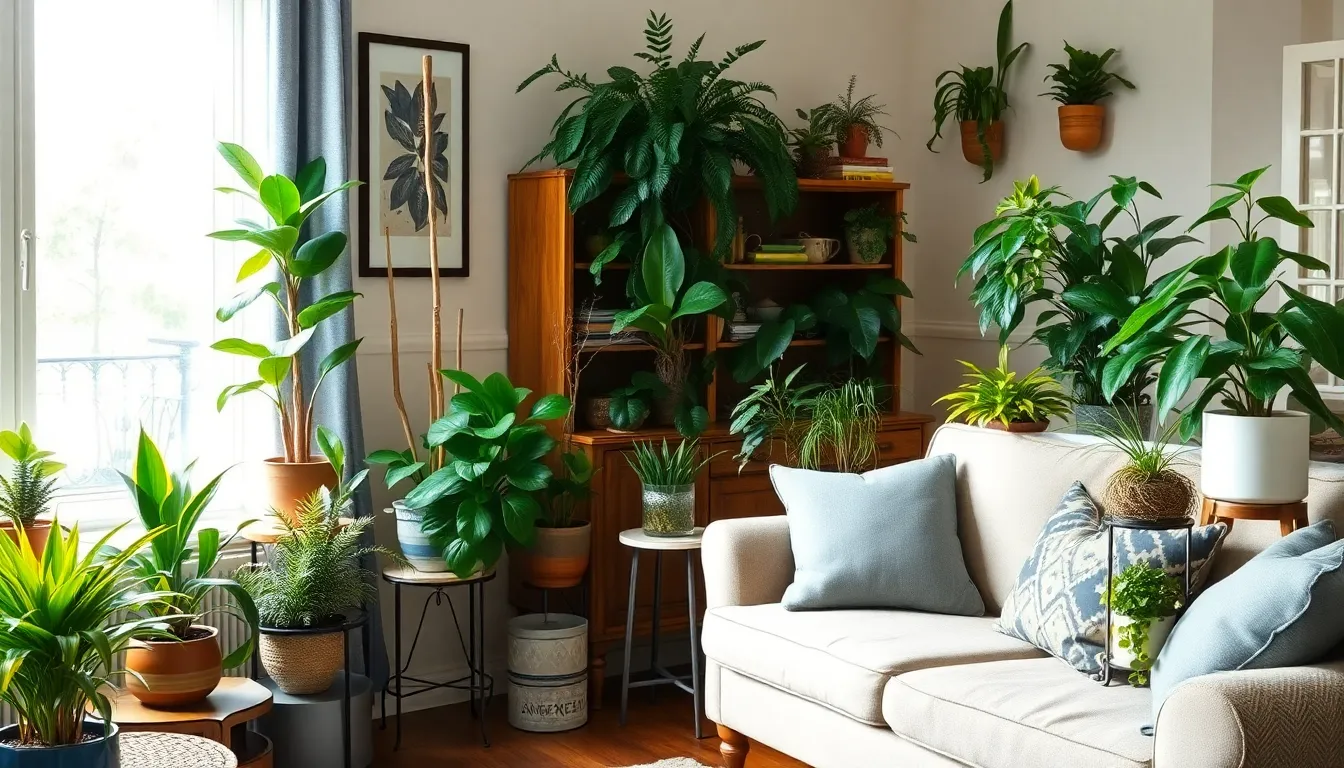
We can transform our houseplants from simple greenery into stunning interior design elements by incorporating the right decorative accessories and thoughtful styling choices.
Add Complementary Design Elements
Surrounding our plants with carefully chosen decorative objects creates a cohesive and visually rich display that amplifies their natural beauty. Art pieces, wall hangings, and small decorative accessories work together to enhance the overall impact of our plant arrangements, making them feel intentional rather than randomly placed.
Layering plants at different heights using shelves or stands adds dimensional interest while helping to balance room proportions naturally. We can soften harsh architectural elements like partition shelving by strategically placing plants nearby, creating a more welcoming and organic feel throughout our space.
Embracing an abundant botanical theme by clustering multiple plants together transforms any room into an immersive indoor jungle experience. This approach boosts both the ambiance and freshness of our living spaces while creating a dramatic focal point that draws attention and admiration.
Vintage furniture pieces like old dressers can serve as unique plant shelves, adding character to rustic or eclectic interior styles. These repurposed elements bring personality to our displays while providing practical surfaces for showcasing our favorite specimens.
Choose the Right Plant Stakes and Supports
Selecting appropriate stakes and supports ensures our larger and climbing plants maintain both their health and attractive appearance over time. Natural wooden stakes blend seamlessly with rustic design schemes, while sleek metal supports complement modern interior aesthetics perfectly.
Proper spacing between supported plants prevents overcrowding and ensures each specimen receives adequate airflow for healthy growth. We should match our support structures to both the plant’s natural growth pattern and our overall decor style for the most harmonious results.
Modern metal plant stands work exceptionally well for contemporary spaces, offering clean lines that don’t compete with our plants for visual attention. Hanging baskets and terrariums create valuable vertical interest, especially beneficial in smaller spaces where floor area is limited.
Displaying epiphytes such as air plants or orchids on suspended branches or rustic ladders adds unique charm and showcases these special plants’ natural growing habits. These creative support answers become decorative elements themselves while providing the functional structure our plants need to thrive.
Maintain Your Indoor Plant Display
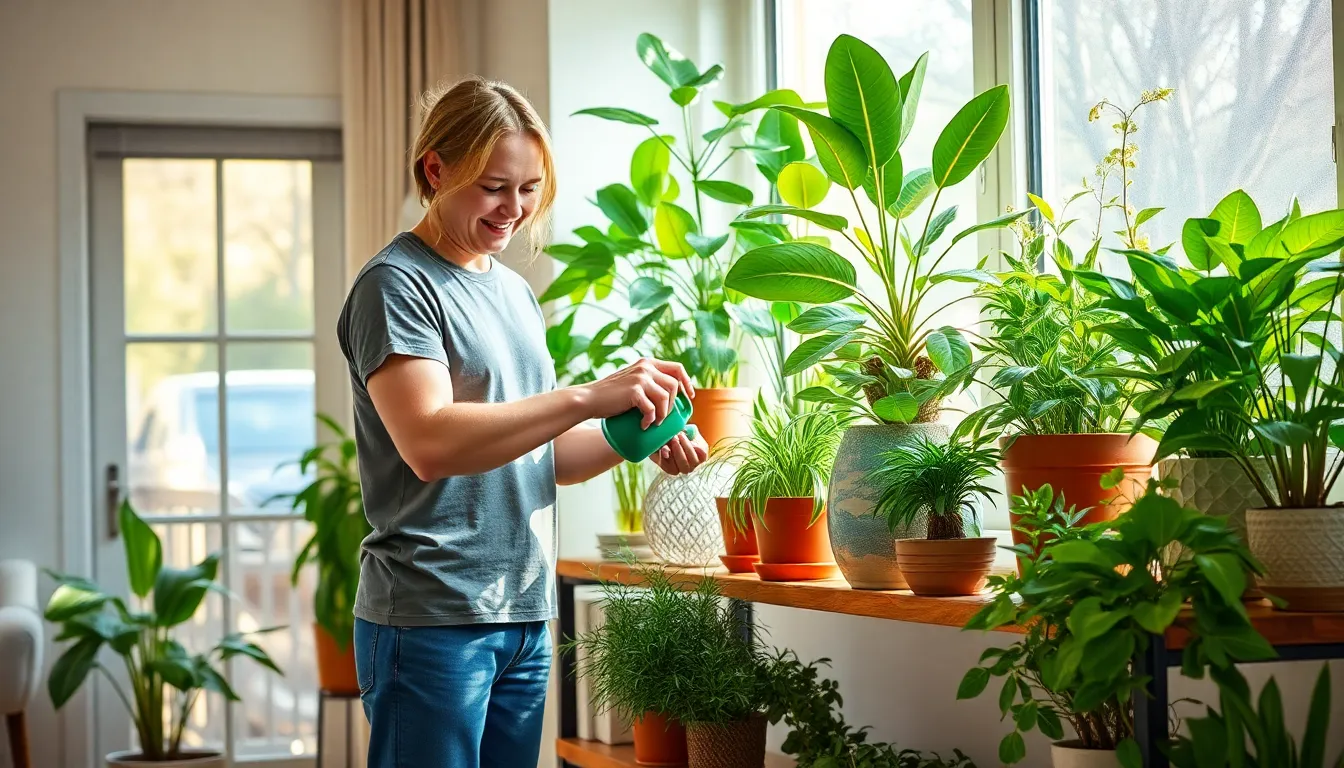
Creating stunning indoor plant displays requires ongoing care to keep them looking their best. We’ll guide you through essential maintenance practices that ensure your plants remain healthy and visually appealing.
Establish a Regular Care Routine
Watering consistency forms the foundation of successful plant care. We recommend checking soil moisture levels weekly by inserting your finger about two inches deep into the soil. Most houseplants need water when the top inch feels dry to the touch.
Pruning dead leaves prevents disease and maintains aesthetic appeal. We suggest removing yellowing or brown leaves immediately using clean scissors or pruning shears. This practice redirects the plant’s energy toward healthy growth and keeps your displays looking fresh.
Fertilizing periodically supports vigorous plant development. We apply balanced liquid fertilizer every 4-6 weeks during the growing season (spring and summer). Indoor plants typically require less frequent feeding than outdoor varieties due to slower growth rates.
Monitoring for pests protects your entire plant collection. We inspect leaves weekly for signs of spider mites, aphids, or scale insects. Early detection allows for quick treatment using insecticidal soap or neem oil before infestations spread to neighboring plants.
Rotate Plants for Even Growth
Turning plants regularly prevents lopsided development and maintains symmetrical shapes. We rotate our plants a quarter turn every two weeks to ensure all sides receive equal light exposure. This simple practice keeps plants growing straight and full rather than leaning toward their light source.
Balanced sunlight exposure promotes healthy foliage on all sides. We’ve noticed that plants near windows often develop fuller growth on the side facing the glass. Regular rotation redistributes this growth energy, creating more uniform and attractive specimens.
Strategic repositioning accommodates seasonal light changes. We move plants closer to windows during winter months when daylight hours decrease. Summer positioning often requires pulling plants back from intense direct sunlight to prevent leaf scorching.
Documenting rotation schedules helps maintain consistency. We mark our calendar or use plant care apps to track when each plant was last rotated. This systematic approach ensures no plant gets overlooked in our maintenance routine.
Design Theme-Based Plant Displays
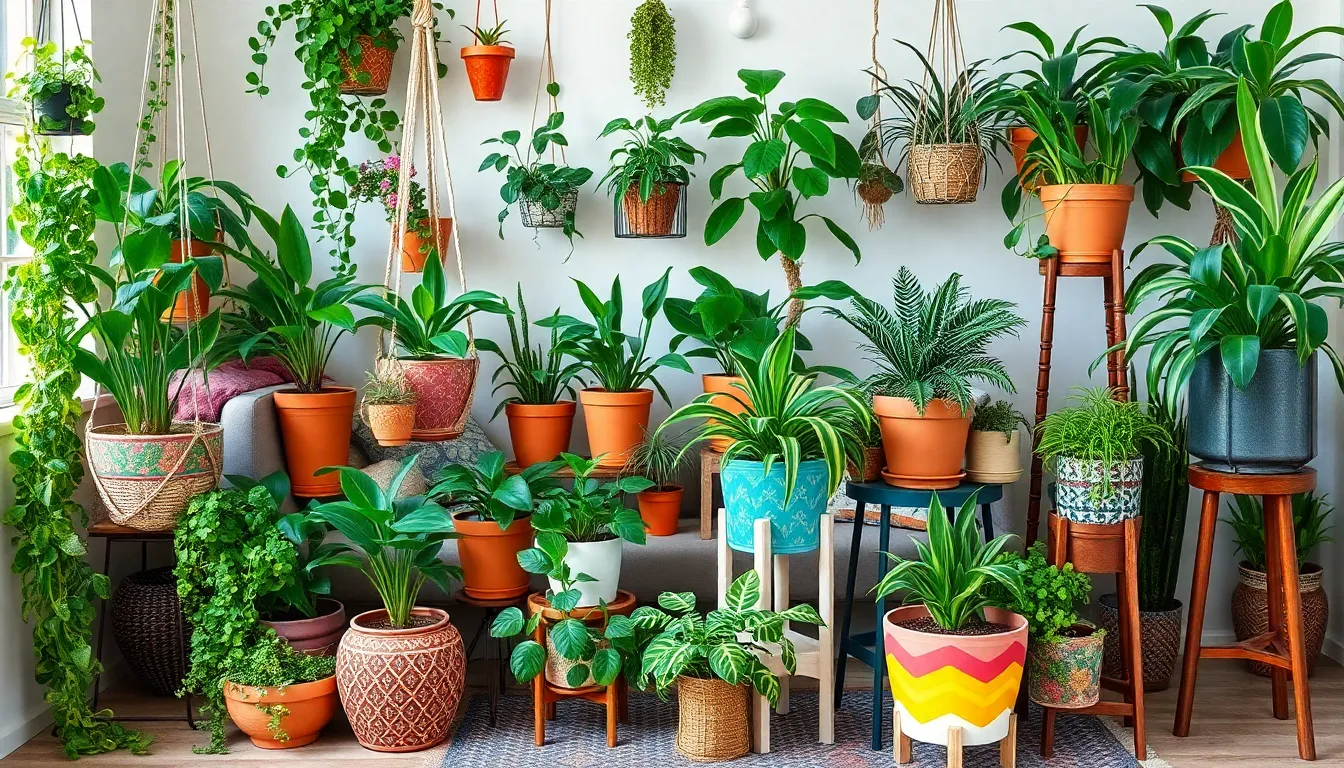
We’ll explore how to create cohesive plant displays that match your interior design aesthetic. These theme-based arrangements transform scattered plants into intentional design statements.
Create Modern Minimalist Arrangements
Modern minimalist plant displays focus on simplicity and clean lines to create elegant, uncluttered spaces. We recommend selecting low-maintenance plants like succulents, cacti, snake plants, pothos, and spider plants that thrive with minimal watering and light requirements.
Plant Selection Strategy: Choose plants with sleek architectural shapes or delicate foliage that won’t overwhelm your space. These varieties complement minimalist aesthetics while requiring minimal care, making them perfect for busy lifestyles.
Arrangement Principles: Group plants in small clusters of two or three to avoid visual clutter. We suggest positioning plants with clean geometric forms that enhance rather than compete with your existing decor.
Container Guidelines: Select containers with neutral colors such as white, soft gray, or muted green to maintain visual calm. Avoid bold colors or ornate pots that disrupt the minimalist aesthetic.
Scale Considerations: Match plant size to your room dimensions by choosing compact plants for smaller spaces. For vertical interest without bulk, we recommend taller, slender plants like snake plants or peace lilies.
Build Bohemian and Eclectic Collections
Bohemian plant displays embrace variety and personal expression through diverse textures, colors, and creative arrangements. We encourage mixing various plant species to create vibrant, layered displays that reflect your unique style.
Plant Variety: Combine different plant types with contrasting textures, leaf shapes, and growth patterns. We suggest including trailing plants, upright specimens, and bushy varieties to create visual depth.
Container Diversity: Use colorful and patterned pots alongside macrame hangers and unique stands. These varied containers add personality and create conversation pieces throughout your space.
Layered Arrangements: Position plants at different heights using vintage furniture, handmade stands, and creative repurposed items. We recommend creating multiple levels to establish visual interest and accommodate various plant sizes.
Personal Touches: Incorporate meaningful objects like travel souvenirs, artwork, or family heirlooms among your plants. These personal elements transform your display into a reflection of your experiences and interests.
Color Coordination: Embrace bold hues and mixed patterns while maintaining some visual connection through repeated colors or materials. We suggest using one or two accent colors throughout your collection to create cohesion within the eclectic style.
Optimize Plants for Different Room Functions
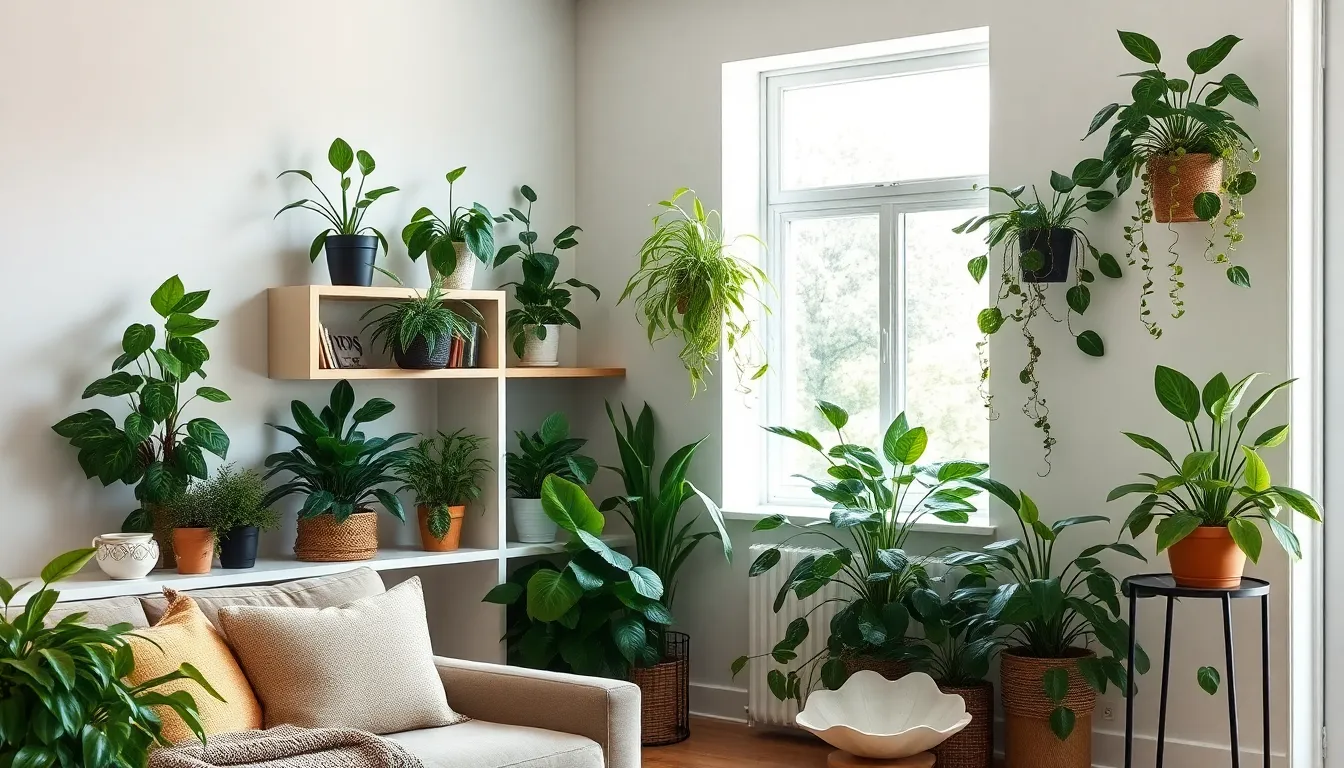
We can maximize our indoor plant displays by tailoring our selections to each room’s unique environment and purpose. Matching plants to exact spaces creates both visual harmony and optimal growing conditions.
Enhance Living Spaces with Statement Plants
Transform your main living areas into vibrant botanical showcases using sculptural plants like Devil’s Ivy, Snake plants, and Philodendrons placed at varying heights. We recommend positioning these statement pieces on partition shelves to subtly zone open plan rooms while maintaining airflow and light circulation.
Create eye catching centerpieces by grouping multiple plants together in unique containers such as large clam shells for dining tables. This approach draws immediate attention and serves as a conversation starter during gatherings.
Layer plants at different heights throughout your living space, combining cascading and upright varieties like ferns, spider plants, and succulents on shelves. We’ve found that hanging some plants from ceilings or placing them in front of windows maximizes greenery and creates an immersive, lush environment.
Make plants your core design feature rather than treating them as afterthoughts. A densely foliaged room offers continual visual interest and maintains an uplifting atmosphere when your plants flourish together in abundance.
Add Greenery to Bedrooms and Bathrooms
Position potted plants strategically in bedrooms near textured accent walls or reading nooks to foster serenity and calm. We suggest placing plants on bedside tables or near windows to personalize the space without overwhelming the restful atmosphere.
Select humidity loving plants for bathrooms such as ferns or tropical species that thrive in moist air conditions. Spread these plants evenly around the space on countertops or shelves to enhance the spa like feel while coordinating with your existing tiles or wall decor.
Group plants in unique planters like shells or textured pots to add charm and greenery without sacrificing precious space. We recommend blending your plant selections with boho or natural decor elements to create a cozy, harmonious vibe that promotes relaxation.
Avoid overcrowding bedroom spaces to maintain the peaceful environment essential for quality rest. Instead, choose fewer, well placed specimens that contribute to the calming atmosphere while complementing your existing furniture and color scheme.
Troubleshoot Common Indoor Plant Display Issues
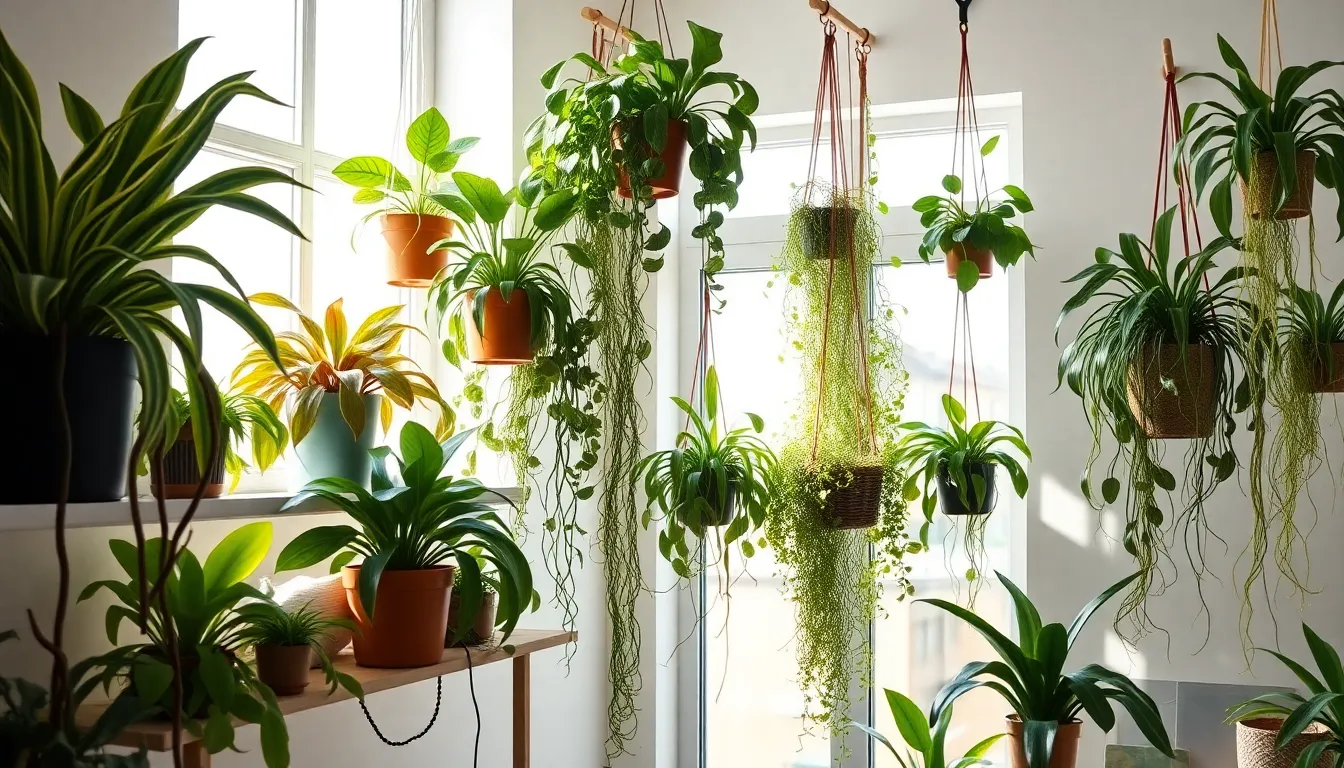
Even the most carefully planned indoor plant displays can encounter challenges that affect both plant health and visual appeal. We’ll help you identify and resolve the most common issues that can undermine your beautiful botanical arrangements.
Address Poor Growth and Wilting Problems
Light requirements drive successful plant growth, so we recommend evaluating whether each plant receives adequate illumination based on its exact species needs. Natural light limitations often require supplemental grow lights to maintain healthy foliage and prevent leggy growth patterns.
Watering practices frequently cause the most plant display problems we encounter in indoor settings. Overwatering leads to root rot and yellowing leaves, while underwatering creates drooping stems and crispy leaf edges. We suggest checking soil moisture levels regularly and adjusting schedules according to seasonal changes in humidity and temperature.
Drainage becomes critical for preventing root diseases that can quickly spread through grouped plant arrangements. Pots without drainage holes trap excess moisture and create anaerobic conditions that kill root systems. We always use containers with proper drainage and place saucers underneath to protect surfaces.
Pest inspection should occur weekly to catch infestations before they damage multiple plants in your display. Common indoor pests like spider mites, aphids, and scale insects spread rapidly between closely positioned plants. We recommend isolating affected plants immediately and treating with appropriate organic or chemical answers.
Solve Space and Lighting Limitations
Vertical display strategies maximize floor space while creating impressive green walls that draw attention upward. Hanging plants from ceiling hooks or mounting wall planters transforms unused vertical areas into thriving botanical features. We position hanging displays in front of windows to optimize natural light exposure for trailing species.
Window placement optimizes available natural light for plants that struggle in interior locations with limited illumination. We rotate plants periodically to ensure even light distribution across all leaf surfaces and prevent one sided growth patterns that create unbalanced appearances.
Low light tolerant species solve dim corner challenges where traditional flowering plants fail to thrive. Snake plants, pothos, and ZZ plants maintain attractive foliage in spaces with minimal natural light. We group these hardy species together to create lush displays in previously unusable areas.
Strategic plant rotation ensures balanced growth across your entire display arrangement. We move plants between locations every few weeks to provide equal light exposure and maintain symmetrical shapes that enhance visual appeal.
Conclusion
Creating captivating indoor plant displays transforms your home into a living sanctuary that reflects your personal style. We’ve explored everything from selecting the right plants for your space to mastering strategic placement techniques that maximize visual impact.
Remember that successful indoor gardening isn’t just about the plants themselves – it’s about creating harmonious arrangements that complement your lifestyle and home’s aesthetic. Whether you prefer minimalist displays or lush botanical collections the key lies in understanding your space and maintaining consistent care routines.
Your indoor garden journey starts with small steps. Begin with low-maintenance plants and gradually expand your collection as you gain confidence. With proper planning and attention to detail you’ll soon enjoy a thriving indoor oasis that brings natural beauty into every corner of your home.
Frequently Asked Questions
What are the best low-maintenance plants for beginners?
Succulents, pothos, snake plants, and ZZ plants are ideal for beginners. These species are forgiving and require minimal care while still providing visual impact. Succulents need infrequent watering, pothos can tolerate various light conditions, and snake plants are extremely drought-tolerant. Start with these varieties to build confidence before advancing to more demanding plants like fiddle leaf figs.
How do I choose the right containers for my indoor plants?
Select porous materials like terracotta or ceramics for optimal moisture regulation. Ensure proper drainage holes to prevent root rot. Match pot sizes to plant types – small herbs need 4-6 inch pots, while larger plants require 8-12 inch containers. Choose styles that complement your home decor for a cohesive look throughout your space.
What is the Rule of Odds in plant arrangements?
The Rule of Odds suggests grouping plants in odd numbers (three, five, or seven) for natural balance and visual appeal. This creates more dynamic and interesting displays than even-numbered arrangements. Combine plants of varying heights and textures within these groupings to add dimensional interest and create captivating focal points in your indoor garden.
How can I maximize vertical space for plant displays?
Use wall-mounted planters, tiered shelving systems, and hanging planters to create vertical gardens. Install plant stands at varying heights and utilize cascading arrangements to transform unused wall space into green focal points. This approach maximizes your growing area while creating dramatic visual impact, especially beneficial for smaller living spaces.
What factors should I consider when placing plants indoors?
Consider natural light availability, humidity levels, and temperature fluctuations in each room. Position plants near windows for maximum light exposure while avoiding overcrowding. Assess each area’s environmental conditions and match plants accordingly – bright light plants near south-facing windows, low-light varieties in interior spaces, and humidity-loving plants in bathrooms.
How often should I rotate my plants for optimal growth?
Rotate plants weekly or bi-weekly to ensure even light exposure and symmetrical growth. Document rotation schedules to track which plants have been moved. This practice prevents plants from leaning toward light sources and maintains their shape. Regular rotation also helps identify any developing issues early, allowing for prompt care adjustments.
What are common signs of indoor plant problems?
Watch for yellowing leaves (overwatering), brown leaf tips (underwatering or low humidity), stunted growth (insufficient light), and pest infestations (small insects or webbing). Wilting can indicate both overwatering and underwatering. Address issues promptly by adjusting watering schedules, improving drainage, relocating plants for better light, or treating pest problems with appropriate solutions.
How do I create cohesive plant displays that match my decor?
For modern minimalist styles, choose plants with clean lines and neutral containers. For bohemian aesthetics, embrace diverse textures and unique planters. Group plants from the same family for cohesive displays, or mix complementary species. Incorporate decorative accessories and vary heights using shelves or stands to create layered, visually rich arrangements that reflect your personal style.

